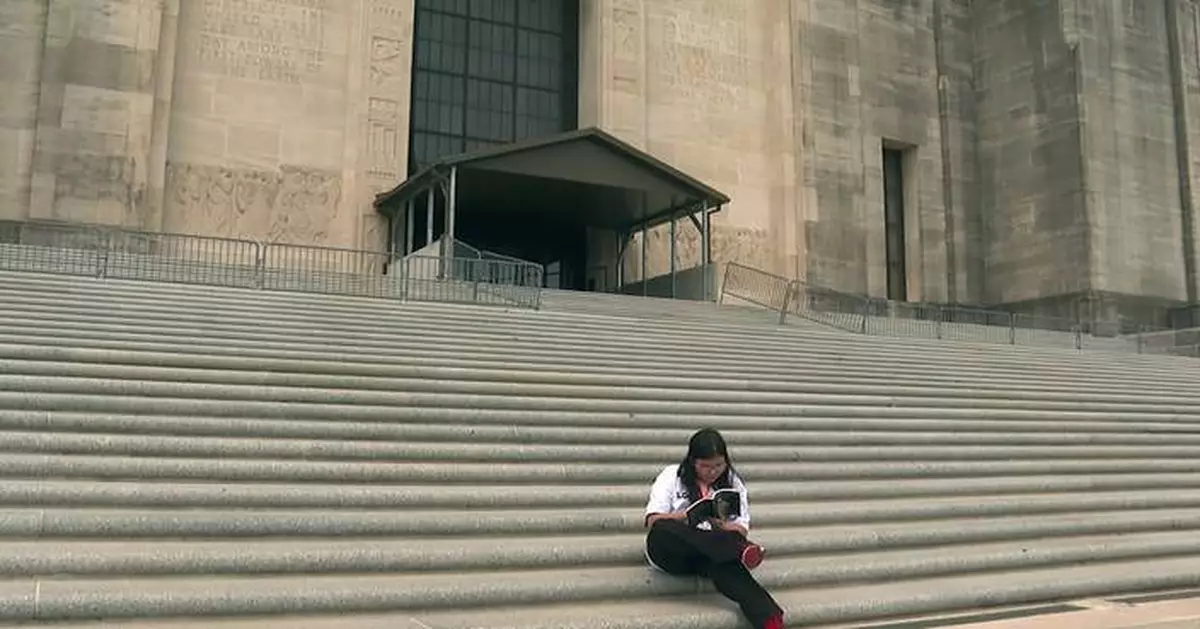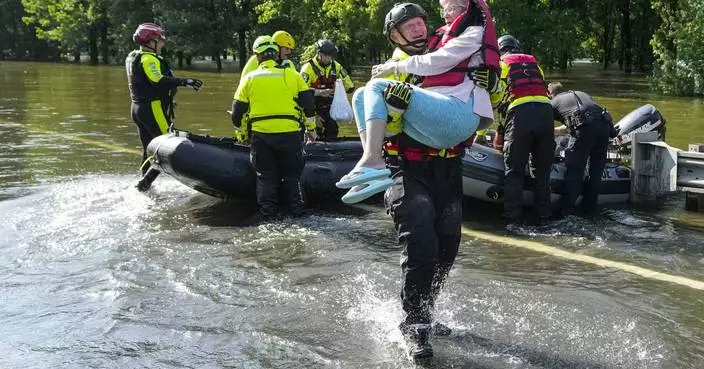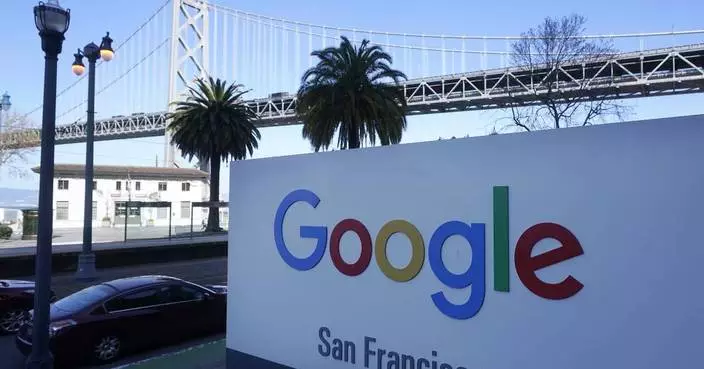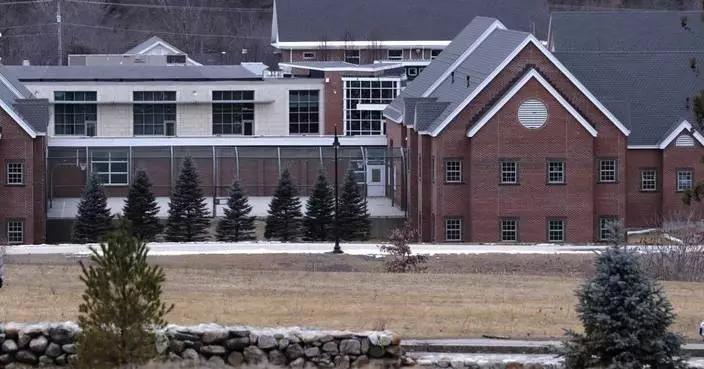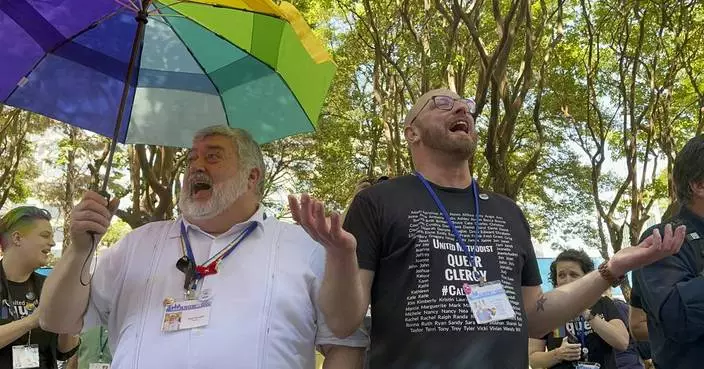BATON ROUGE, La. (AP) — As transgender people in Louisiana watched surrounding states in the deeply conservative South implement a slew of laws targeting nearly every facet of their lives in recent years, they counted on their ally in the governor’s office to keep their home a relative oasis.
Former Gov. John Bel Edwards, the only statewide elected Democrat at the time, was indeed able to block most of the bills.
But this year, nothing stands in the way. Edwards has been replaced by Gov. Jeff Landry, a Republican backed by former President Donald Trump who has shown support for such legislation. And the GOP holds a two-thirds supermajority in the Legislature. That means previously introduced legislation hostile to transgender people now has a clear path forward, as do new proposals.
“These bills are absolutely going to become law,” said SarahJane Guidry, executive director of the LGBTQ+ rights group Forum for Equality. “And that is such a tragedy, but it doesn’t end there. We are going to continue to fight.”
As the only Democratic governor in the Deep South at the time, Edwards used vetoes to block anti-transgender legislation, including one broadly barring teachers from discussing gender identity and sexual orientation in schools, a type of policy critics have dubbed “Don’t Say Gay”; and a measure requiring public school teachers to use the pronouns and names students were assigned at birth.
In a veto message, Edwards described the bills as discriminatory, extremist and harmful to a group “comprised of the most vulnerable, fragile children” in Louisiana.
He was unable to keep the Legislature from overriding his veto of a ban on gender-affirming medical care for transgender minors. And he blocked a 2021 bill seeking to restrict transgender athletes' access to sports, but allowed it become law the next year, knowing a veto would probably be overridden.
Now that Edwards is out of office because of term limits, the Republican-controlled Legislature is advancing the “Don't Say Gay” and pronoun and name proposals; definitions of male and female that could effectively legally erase transgender people; and restrictions on the use of bathrooms and changing rooms in schools, domestic violence shelters and prisons. President Joe Biden’s administration has said a new federal rule could clash with such bathroom restrictions.
The situation in Louisiana mirrors a national flood of bills that have targeted transgender people, and especially youths, in recent years, a movement some observers say seeks more to motivate conservative voters than to solve real problems.
A report released Tuesday by the Williams Institute, a research center at UCLA Law, estimates that about 93% of transgender youths ages 13-17, or about 280,000, live in states that have proposed or passed laws restricting their access to health care, sports, school bathrooms and facilities, or the use of gender-affirming pronouns.
The institute estimates that in Louisiana, about 4,000 people ages 13-17, or 1.3% of that age group, identify as transgender.
Landry's office did not respond to an email seeking comment on this year's legislation. But he has made no secret of his support for, among other things, restrictions on gender-affirming care for minors. In 2023, when he was running for governor, he posted on X: “As attorney general for 8 years I have worked hard to protect our children. I urge the full Senate to take up and pass” the law. It eventually passed and was vetoed but overridden.
Advocates in the Bayou State are organizing their fight, looking to other states that have blocked similar measures in court, educating their communities on the imminent laws, seeking sanctuary city policies, and recruiting more residents to their cause.
“We’re not going to look to the apocalypse, we’re going to look to the revolution,” Guidry said.
Advocates want the city council in liberal New Orleans to create local protections for transgender people, such as refusing to enforce state laws targeting them. Other cities like Austin, Texas, and Kansas City, Missouri, have already taken similar actions, though it's not clear how effective the protections have been.
Last month, hundreds marched in New Orleans’ French Quarter. Transgender residents continue to testify in the Capitol. Advocates try to work with conservative lawmakers to create amendments to soften legislation. Students took to the Capitol steps in Baton Rouge last month to perform a play they wrote, based on their own experiences about how the bills would affect them.
“It’s almost like the Twilight Zone,” said William Leighton, who drove four hours to the Capitol this month with his 13-year-old transgender daughter, Arielle, who was not in the play.
“It’s not fair. I really don’t like the fact that people like me are being discriminated (against) for being different,” said Arielle, who is in eighth grade.
William Leighton had already prepared a letter to send to Arielle’s teachers, granting permission to use her name and pronouns, but he decided that was not enough and needed to get more politically active.
He was recently elected to the state’s Democratic State Central Committee. Among his priorities are to get more Democrats to vote and find candidates who, if elected to the Legislature, would work to repeal legislation targeting transgender and other LGBTQ+ people.
Like their counterparts in the South and elsewhere, advocates in Louisiana will also look to courts for guidance and to keep legislation from taking effect.
Five transgender youths and their families filed a lawsuit this year against the state's ban on gender-affirming medical care, as reported by The Times-Picayune/The New Orleans Advocate. The suit is pending in Orleans Parish Civil Court.
“Nothing is off the table,” Guidry said. “If we cannot protect our students, we will continue to work, and if that includes litigation, we will take those steps when we need to.”

SarahJane Guidry, executive director of Forum for Equality, sits in the Louisiana House chamber in Baton Rouge, La., on Tuesday, April 16, 2024. Guidry, an LGBTQ+ advocate, has testified in opposition to proposed bills in Louisiana that target transgender people. (AP Photo/Stephen Smith)
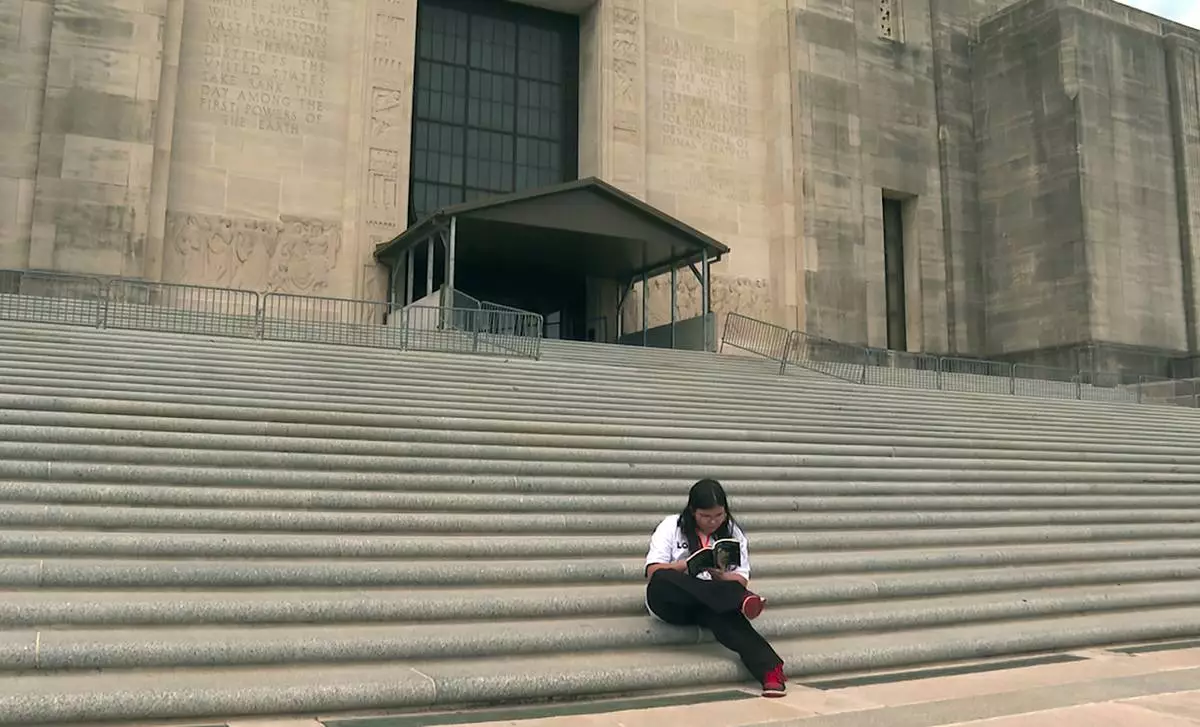
Arielle Leighton, 13, reads on the Louisiana Capitol steps in Baton Rouge, La., on Tuesday, April 16, 2024. The eighth grader, who is a transgender girl, visited the state building with her Dad to oppose bills targeting the state’s LGBTQ+ community. (AP Photo/Stephen Smith)
FITZGERALD, Georgia (AP) — On-the-ground preparations are on track in Gaza for humanitarian workers to be ready to deliver food, treatment for starving children and other urgent assistance by early or mid-May when the American military expects to finish building a floating pier to receive the shipments, a U.S. Agency for International Development official said Friday.
Ramping up the delivery of aid on a planned U.S.-backed sea route will be gradual as aid groups test the distribution and security arrangements for relief workers, the USAID official told The Associated Press.
The official spoke on condition of anonymity over security concerns for work done in a conflict zone. They were some of the agency’s first comments on the status of preparations for the Biden administration’s $320 million Gaza pier project, for which USAID is helping coordinate on-the-ground security and distribution.
Meanwhile, at a factory in rural Georgia on Friday, USAID Administrator Samantha Power pointed to the food crises in Gaza and other parts of the world as she announced a $200 million investment aimed at increasing production of emergency nutritional paste for starving children under 5.
Power spoke to factory workers, peanut farmers and local dignitaries sitting among pallets of the paste at the Mana nonprofit in Fitzgerald. It is one of two factories in the U.S. that produces the nutritional food, which is used in clinical settings and made from ground peanuts, powdered milk, sugar and oil, ready to eat in plastic pouches resembling large ketchup packets.
“This effort, this vision meets the moment,” Power said. "And it could not be more timely, more necessary or more important.”
With the Israel-Hamas war stretching close to seven months and Israel restricting humanitarian aid, half of Gaza's 2.3 million people are at imminent risk of famine, international health officials say. Under pressure from the U.S. and others, Israeli officials in recent weeks have begun slowly reopening some border crossings for relief shipments.
But aid coming through the sea route, once it's operational, still will serve only a fraction — half a million people — of those who need help in Gaza. Aid organizations including USAID stress that getting more aid through border crossings is essential to staving off famine in the territory.
Children under 5 are among the first to die when wars, droughts or other disasters curtail food. Hospital officials in northern Gaza reported the first deaths from hunger in early March and said most of the dead were children.
The panel that serves as the internationally recognized monitor for food crises said earlier this year that northern Gaza was on the brink of famine and likely to experience it by this month. While the next update will not come before this summer, it's clear that so far there has not been enough food getting to north Gaza to avert famine, the USAID official said.
Power said the U.N. has called for 400 metric tons of the nutritional paste in the Palestinian territory “in light of the severe hunger that is pervading across Gaza right now, and the severe, acute humanitarian crisis.” USAID expects to provide a quarter of that, she said.
Globally, she said at the Georgia factory, the treatment made there “will save untold lives, millions of lives.”
USAID is coordinating with the U.N. World Food Program and other humanitarian partners and governments on security and distribution for the pier project, while U.S. military forces finish building it. President Joe Biden, under pressure to do more to ease the humanitarian catastrophe in Gaza as the U.S. provides military support for Israel, announced the project in early March.
U.S. Central Command said in a statement Friday that offshore assembly of the floating pier has been temporarily paused due to high winds and sea swells, which caused unsafe conditions for soldiers. The partially built pier and the military vessels involved have gone to Israel's Port of Ashdod, where the work will continue.
A U.S. official said the high seas will delay the installation for several days, possibly until later next week. The official, who spoke on condition of anonymity to discuss operation details, said the pause could last longer if the bad weather continues because military personnel and divers have to get into the water for the final installation.
The United Nations has been muted about its role in the aid deliveries.
“We want to see more land operations. This is a sea operation," U.N. spokesman Stephane Dujarric said Wednesday. "We are working with them, but obviously we have certain parameters that need to be respected, notably the basic humanitarian principles that we have of independence and being free from all sorts of military.”
The struggles this week with the first aid delivery through a newly reopened land corridor into north Gaza underscored the uncertainty about security and the danger still facing relief workers. Israeli settlers blocked the convoy before it crossed Wednesday. Once inside Gaza, the convoy was commandeered by Hamas militants, before U.N. officials reclaimed it.
In Gaza, the nutritional treatment for starving children is most urgently needed in the northern part of the Palestinian territory. Civilians have been cut off from most aid supplies, bombarded by Israeli airstrikes and driven into hiding by fighting.
Acute malnutrition rates among children under 5 have surged from 1% before the war to 30% five months later, the USAID official said. The official called it the fastest such climb in hunger in recent history, more than in grave conflicts and food shortages in Somalia or South Sudan.
One of the few medical facilities still operating in northern Gaza, Kamal Adwan hospital, is besieged by parents bringing in thousands of children with malnutrition for treatment, the official said. Aid officials believe many more starving children remain unseen and in need, with families unable to bring them through fighting and checkpoints for care.
Saving the gravely malnourished children in particular requires both greatly increased deliveries of aid and sustained calm in fighting, the official said, so that aid workers can set up treatment facilities around the territory and families can safely bring children in for the sustained treatment needed.
Knickmeyer reported from Washington. Associated Press writers Lolita C. Baldor in Washington and Edith M. Lederer at the United Nations contributed.

USAID Administrator Samantha Power speaks with U.S. Rep. Austin Scott on Friday, May 3, 2024, during a tour of the factory where the nonprofit Mana produces emergency nutritional aid in Fizgerald, Ga. Power announced USAID is investing $200 million in emergency food aid for children in Gaza, Sudan and other countries where conflict has driven up need. AP Photo by Russ Bynum Sent from my iPhone

USAID Administrator Samantha Power talks with a worker Friday, May 3, 2024, during a tour of the factory where the nonprofit Mana makes emergency nutritional aid in Fitzgerald, Georgia. Power announced USAID is investing $200 million in emergency nutritional treatment for starving children as conflicts in Gaza, Sudan and elsewhere drive up the need. (AP Photo/Russ Bynum)

USAID Administrator Samantha Power talks with Mana operations director Harry Broughton during a tour of its factory in Fitzgerald, Ga., that produces emergency nutritional aid for starving children, on Friday, May 3, 2024. Power announced USAID is investing $200 million to increase nutritional aid for starving children in Gaza, Sudan and other places where conflict has increased needs. (AP Photo/Russ Bynum)

In this image provided by the U.S. Army, soldiers assigned to the 7th Transportation Brigade (Expeditionary) and sailors attached to the MV Roy P. Benavidez assemble the Roll-On, Roll-Off Distribution Facility (RRDF), or floating pier, off the shore of Gaza on April 26, 2024. The U.S. expects to have on-the-ground arrangements in Gaza ready for humanitarian workers to start delivering aid this month via a new U.S.-backed sea route for Gaza aid. An official with the U.S. Agency for International Development tells the AP that humanitarian groups expect to have their part of preparations complete by early to mid-month. (U.S. Army via AP)




